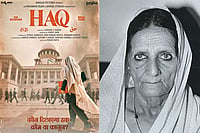I have spent most of my school summer vacations in Pondicherry. My paternal grandfather ran a lodge-cum-canteen there and I had dozens of uncles, aunts and cousins of all ages. We would hurtle down the sleepy little lanes in cycles, getting our hands burning with boils as we tried to rip open the cashew kernel from the milky fruit in a nearby plantation and, of course, every afternoon walk down to the beach, splash around in the sea till it was dark and return home with the sandy slippers in our hands.
For a long time, Pondicherry for me was just like any other Tamil town, with its men in lungis and women with cloying jasmine, ‘Meals Ready’ ‘Ootels’ and the blazing, white sun, though there would be some curious differences: the cycle-rickshawallah or bus conductor would address my father as ‘misa’ (derived from monsieur), not ‘saar’ like in Madras, the streets were ‘roo’ (rue) and Bastille Day was a big deal, which would fall while we were there in the summer. Years later, when friends talked of the tranquility of Auroville or the authentic European cuisine in the sidewalk cafes, I would be foxed. Where was this Pondicherry, how did we miss it in our summer holidays, did it only come up later? Aditi Sriram’s book answers all those questions.
The author, too, has a distant connect with Pondicherry and she sets out to find out everything about the city with Napoleonic vigour. The White Town, still called so, the French-coastal town-like promenade, the imposing and austere Sri Aurobindo Ashram, the officious and phlegmatic JIPMER, the aging Old Lighthouse, the busy Gandhi Thidal, the bustling Barathi Park, Rathna Theatre, The Eglise de Notre Dame des Anges, Manakula Vinayagar Kovil, Rue Caron, Rue Chermon and Rue Latouche, the Muslim Quarter, and Auroville, all come alive. Sriram’s enthusiasm is infectious and the reader hobbles along with her to walk with Peter Heehs, historian and guardian angel of the city, to meet Thribhuvan Manoharan, the owner of Rathna Theatre, chat with the frail Lata di and Urmila di who have taught in the Ashram’s school with Sri Aurobindo and Mother, discuss how plural the culture of the place is with Father A.S. Antonisamy or just shoot the breeze riding pillion on Aneesh Raghava’s motorbike.
Sriram, who teaches writing at Ashoka University, brings in her academic rigour (a book this slim has 177 notes at the end) and dives deep into Pondicherry’s history, geography and anthropology. Its complex relationship with the French—a sort of a poor cousin whom the French neither accepted wholeheartedly nor abandoned entirely—is discussed at length. The only two things I found missing in the book from my memories of those summer holidays, and a few subsequent trips later, is the weather—hot and humid one minute, blustery and drenched the next—and the food, quite the same like the sappadu from the other nearby towns of Tamil Nadu and yet so different, with the surprising existence of a crepe stall in the middle of idli-vadai vendors.



























